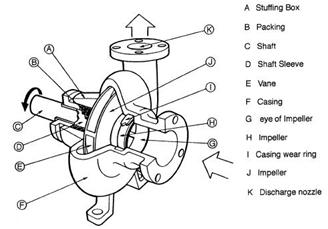The pump operates by the principle of making a difference in pressure between the entrance (suction) to the exit (discharge). In other words, the pump function transform mechanical power from a power source (driving) into kinetic energy (speed), where power is useful to drain the fluid and overcome the barriers that exist throughout the drainage.
Centrifugal pumps
One type of non-positive transfer pump is a centrifugal pump that works to change the principle of kinetic energy (velocity) of fluid into potential energy (dynamic) through an impeller which rotates in the casing.
In accordance with the data obtained, the reboiler pump debutanizer in Hidrokracking Unibon using centrifugal pump single - stage double suction.
Centrifugal Pump Classification
Centrifugal pumps can be classified, based on:
1. capacity:
Low Capacity <20 m3 / h
Medium capacity 20 -: - 60 m3 / h
High-capacity> 60 m3 / h
2. Discharge Pressure:
Low Pressure <5 Kg / cm2
Medium pressure 5 -: - 50 Kg / cm2
High pressure> 50 Kg / cm2
3. Number / composition of Impeller and Levels:
Single stage: Consists of an impeller and a casing
Multi stage: Consists of several impeller arranged in a single chassis series.
Multi Impeller: Consists of several impeller arranged parallel in a single casing.
Multi Impeller â € "Multi-stage: The combination of multi-impeller and multi stage.
4. Position Axis:
vertical shaft
horizontal shaft
5. Suction Number:
Single Suction
Double Suction
6. Impeller exit flow direction:
radial flow
axial flow
mixed fllow
Main parts of Centrifugal Pumps
In general, major parts of the centrifugal pump can be seen like-the following picture:
Centrifugal pumps can be classified, based on:
1. capacity:
Low Capacity <20 m3 / h
Medium capacity 20 -: - 60 m3 / h
High-capacity> 60 m3 / h
2. Discharge Pressure:
Low Pressure <5 Kg / cm2
Medium pressure 5 -: - 50 Kg / cm2
High pressure> 50 Kg / cm2
3. Number / composition of Impeller and Levels:
Single stage: Consists of an impeller and a casing
Multi stage: Consists of several impeller arranged in a single chassis series.
Multi Impeller: Consists of several impeller arranged parallel in a single casing.
Multi Impeller â € "Multi-stage: The combination of multi-impeller and multi stage.
4. Position Axis:
vertical shaft
horizontal shaft
5. Suction Number:
Single Suction
Double Suction
6. Impeller exit flow direction:
radial flow
axial flow
mixed fllow
Main parts of Centrifugal Pumps
In general, major parts of the centrifugal pump can be seen like-the following picture:

A. Stuffing BoxStuffing Box serves to prevent leakage in the area where the shaft penetrates the pump casing.
B. PackingUsed to prevent and reduce the leakage of fluid from the pump casing through the shaft. Usually made of asbestos or Teflon.
C. Shaft (shaft)Shaft serves to continue the torque from the drive during operation and the locus of the impeller and other rotating parts.
D. Shaft sleeveShaft sleeve serves to protect the shaft from erosion, corrosion and wear of the stuffing box. In multi-stage pump can be as joint leakage, internal or interstage bearings and distance sleever.
E. VaneBlade of the impeller as a place of passage of fluid in the impeller.
F. CasingIs the outermost part of the pump that serves as a protective element that rotates, the seat of diffusor (guide vane), inlet and outlet nozzles as well as a place to give direction to convert the flow from the impeller and the fluid velocity energy into dynamic energy (single stage).
G. Eye of ImpellerThe side entrance on the direction of suction impeller.
H. ImpellerImpeller serves to convert the mechanical energy of the pump energy into velocity in the fluid being pumped continuously, so that the liquid on the suction side of continually going to fill the vacancy caused by the displacement of fluid that entered previously.
I. Wearing RingWearing the ring serves to minimize leakage of fluid passing through the front of the impeller and the back of the impeller, by minimizing the gap between the impeller casing.
J. BearingBeraing (bearing) function to withstand the burden of bearing and shaft to rotate, either in the form of radial loads and axial loads. Bearing also allows the shaft to rotate smoothly and remain in place, so that frictional losses become smaller.
K. CasingIs the outermost part of the pump that serves as a protective element that rotates, the seat of diffusor (guide vane), inlet and outlet nozzles as well as a place to give direction to convert the flow from the impeller and the fluid velocity energy into dynamic energy (single stage).





0 komentar:
Posting Komentar